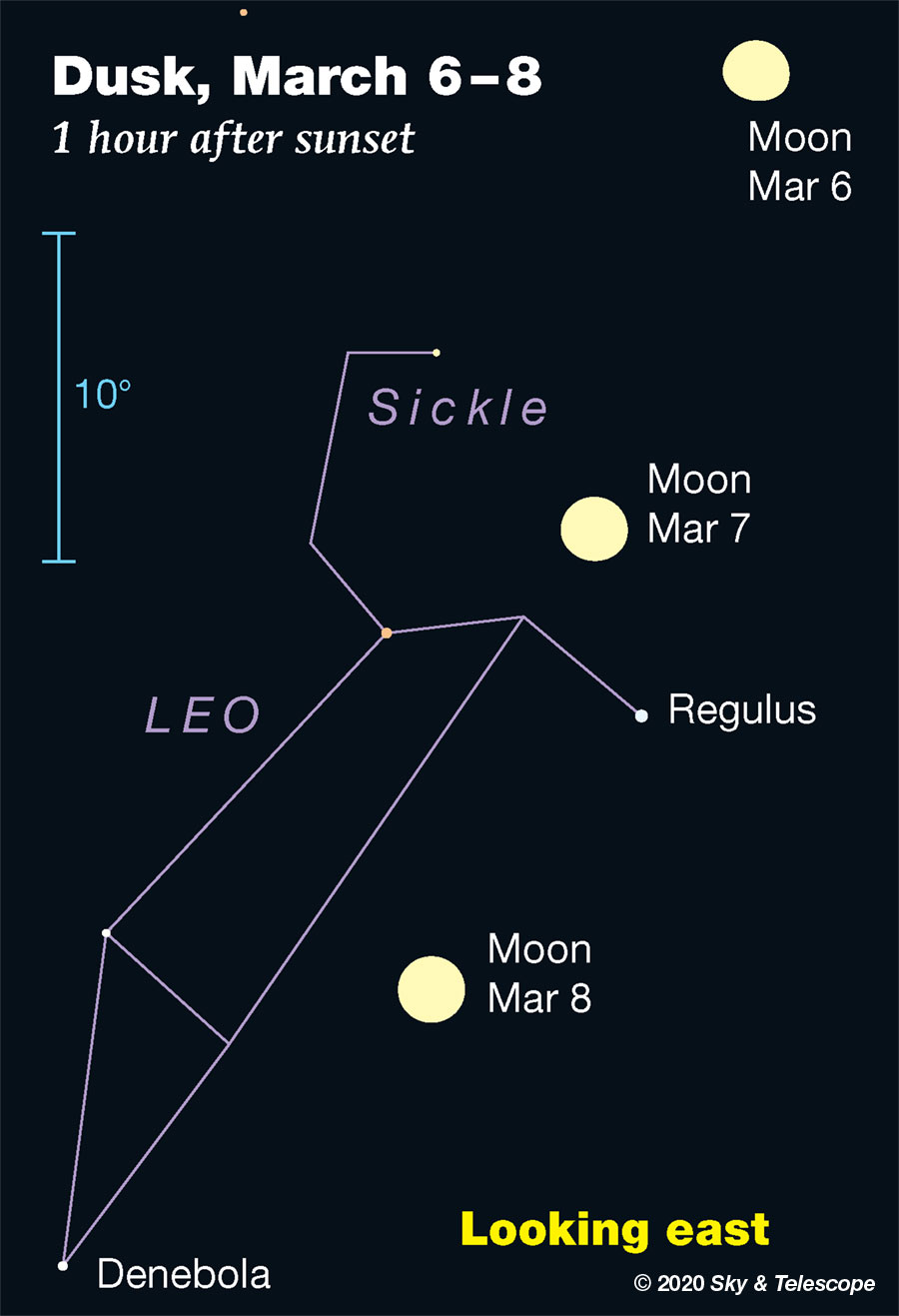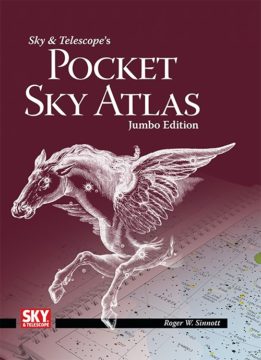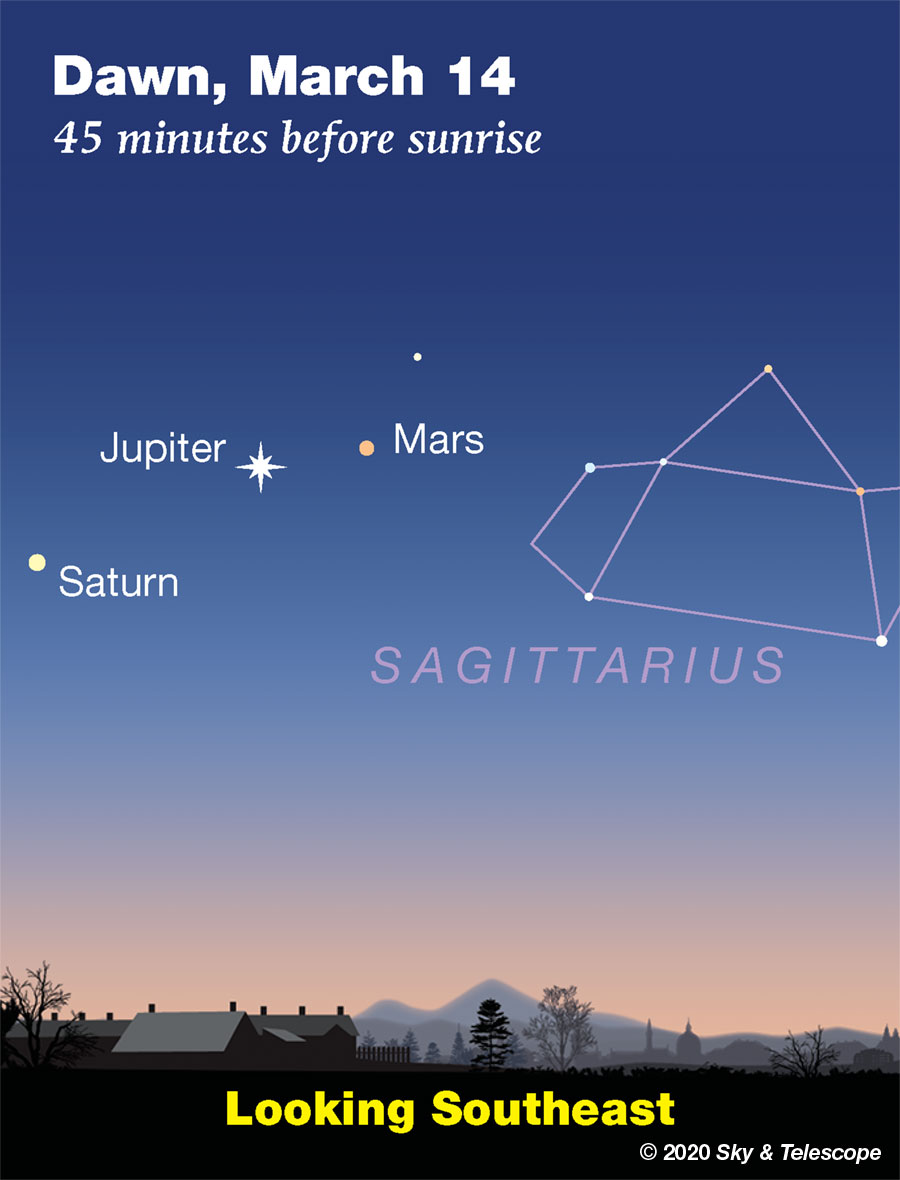Betelgeuse is rebrightening. After bottoming out at about V magnitude +1.64 in early to mid-February, Orion's Betelgeuse was up to +1.3 as of March 8th, and the brightening seems to be speeding up. The difference from minimum is visible by eye; use Orion's other shoulder star, Bellatrix, as a comparison. At minimum they were essentially equal. See The Fall and Rise of Betelgeuse.
Friday, March 6
• It's not officially spring for another 13 days, but the Spring Star Arcturus seems eager to thrust itself into view. It rises above the east-northeast horizon fairly soon after dusk now, depending on your latitude.
Where should you watch for it to rise? Find the Big Dipper as soon as the stars come out, high in the northeast. Follow the curve of its handle down and around to the lower right by a little more than a Dipper-length. That's the spot on the horizon to watch.
Saturday, March 7
• Regulus shines below the nearly full Moon after dark, as shown below. Can you make out the rest of the Sickle of Leo, almost enclosing it, through the moonlight? Binoculars help.

Sunday, March 8
• Daylight-saving time began at 2 a.m. last night for most of North America.
• Venus continues to shine high in the west at nightfall for many weeks on end. But as the season advances, the starry background slides toward the lower right behind it. Not long ago the brightest stars of Aries were high over Venus. Now you'll find them closer to Venus's right or upper right.
And look high above the bright planet for the Pleiades cluster. Tonight they're 25° apart. But the Pleiades are heading toward Venus by 1° per day, and they will engulf it on the evening of April 3rd.
Monday, March 9
• Full Moon (exactly so at 1:48 p.m. EDT). As the Moon climbs the eastern sky this evening, look about 8° or 9° to its upper left for Denebola, the tail star of Leo, magnitude 2.1. Is your sky clean and clear enough for you to see it through the moonlight without binoculars?
Tuesday, March 10
• Bright Sirius now stands due south on the meridian just as twilight fades away into night. Sirius is the bottom star of the equilateral Winter Triangle. The other two stars of the Triangle are orange Betelgeuse to Sirius's upper right (Orion's shoulder) and Procyon to Sirius's upper left.
Sirius is not only the brightest star on the entire celestial sphere (after the Sun), it's also the nearest star that's visible to the naked eye from mid-northern latitudes. (Alpha Centauri is nearer but too far south. A few dim red dwarfs in the northern sky are nearer, but they require optical aid.)
Wednesday, March 11
• More about Sirius and Canis Major. In a very dark sky the Big Dog's realistic stick figure is plain to see — the dog is in profile prancing to the right on his hind legs, with Sirius as his shiny dog tag — but for most of us only his five brightest stars show well through the light pollution. These form the unmistakable Meat Cleaver. Sirius and Murzim (three finger-widths to its right) are the wide front end of the cleaver, with Sirius sparkling on its top back corner. Down to Sirius's lower left is the cleaver's other end, including its short handle, formed by the triangle of Adhara, Wezen, and Aludra. It's chopping toward the lower right.
Thursday, March 12
• On the traditional divide between the winter and spring sky is the dim constellation Cancer. It's between Gemini to its west and Leo to its east.
Cancer holds something unique: the Beehive Star Cluster, M44, in its middle. Look for it a little less than halfway from Pollux in Gemini to Regulus in Leo. The Beehive shows dimly to the naked eye if you have little or no light pollution. With binoculars it's easy, even under worse conditions.
Friday, March 13
• Right after dark at this time of year, five carnivore constellations stand upright in a row (emerging from hibernation?), from the northeast to south. They're all seen in profile with their noses pointed up and their feet (if any) to the right. They are Ursa Major the Big Bear in the northeast (with the Big Dipper as its brightest part), Leo the Lion in the east, Hydra the Sea Serpent in the southeast, Canis Minor the Little Dog higher in the south-southeast, and bright Canis Major the Big Dog in the south.
Saturday, March 14
• At nightfall, the Big Dipper is high in the northeast and beginning to tip left. Look well to its left (about three fists at arm's length) for Polaris and the dim Little Dipper. Other than Polaris, all you may see of the Little Dipper through light pollution are the two stars forming the outer end of its bowl: Kochab (similar to Polaris in brightness) and below it, fainter Pherkad. Find these two "Guardians of the Pole" to Polaris's lower right, by about a fist and a half at arm's length.
Now is the time of year when the Guardians line up exactly vertically around the end of twilight.
Want to become a better astronomer? Learn your way around the constellations. They're the key to locating everything fainter and deeper to hunt with binoculars or a telescope.
This is an outdoor nature hobby. For an easy-to-use constellation guide covering the whole evening sky, use the big monthly map in the center of each issue of Sky & Telescope, the essential guide to astronomy.

Once you get a telescope, to put it to good use you'll need a detailed, large-scale sky atlas (set of charts). The basic standard is the Pocket Sky Atlas (in either the original or the magnified Jumbo Edition), which shows stars to magnitude 7.6.
Next up is the larger and deeper Sky Atlas 2000.0, plotting stars to magnitude 8.5; nearly three times as many. The next up, once you know your way around, are the even larger Interstellarum atlas (stars to magnitude 9.5) and Uranometria 2000.0 (stars to magnitude 9.75). And read how to use sky charts with a telescope.
You'll also want a good deep-sky guidebook, such as Sue French's Deep-Sky Wonders collection (which includes its own charts), Sky Atlas 2000.0 Companion by Strong and Sinnott, or the bigger Night Sky Observer's Guide by Kepple and Sanner.
Can a computerized telescope replace charts? Not for beginners, I don't think, and not on mounts and tripods that are less than top-quality mechanically (meaning heavy and expensive). And as Terence Dickinson and Alan Dyer say in their Backyard Astronomer's Guide, "A full appreciation of the universe cannot come without developing the skills to find things in the sky and understanding how the sky works. This knowledge comes only by spending time under the stars with star maps in hand."
This Week's Planet Roundup
Mercury is hidden deep in the glow of dawn.
Venus (magnitude –4.4, in Aries) is the big, bright "Evening Star" shining in the west during and after twilight. Venus remains up for a good two hours or more after the end of twilight.
In a telescope, Venus is 20 arcseconds in diameter and still slightly gibbous (58% sunlit). It will enlarge in size and wane in phase for the rest of the winter and much of the spring — passing through dichotomy (half-lit phase) in late March before becoming a dramatic thin crescent in May.

Mars, Jupiter, and Saturn (magnitudes, +1.0, – 2.0, and +0.7, respectively) are lined up diagonally low in the southeast as dawn begins. in that order from upper right to lower left. Mars is moving eastward closer and closer to the two giants. On the morning of March 7th it's 7° from bright Jupiter. By the 14th they're only 3° apart, as shown above.
Uranus (magnitude 5.9, in Aries) is getting lower in the west after dark, hiding in the background of Venus.
Neptune is in conjunction with the Sun.
All descriptions that relate to your horizon — including the words up, down, right, and left — are written for the world's mid-northern latitudes. Descriptions that also depend on longitude (mainly Moon positions) are for North America.
Eastern Standard Time (EST) is Universal Time (UT, UTC, GMT, or Z time) minus 5 hours. Eastern Daylight Time (EDT) is UT minus 4 hours.
![]() Audio sky tour. Out under the evening sky with your earbuds in place, listen to Kelly Beatty's monthly podcast tour of the heavens above. It's free.
Audio sky tour. Out under the evening sky with your earbuds in place, listen to Kelly Beatty's monthly podcast tour of the heavens above. It's free.
 5
5
Comments
Pencil BFB
March 6, 2020 at 10:08 am
Neh. If you observe from Manila (14° north) Alpha Centauri culminates 15 degrees over the southern horizon. It never appears to view north of the 29th parallel north (New Delhi) and is circumpolar south of 29°S (Porto Alegre, Brazil).
You must be logged in to post a comment.
Rod
March 9, 2020 at 1:47 pm
Last night was lovely at my location. Yes indeed, Venus and Uranus meet up and last night I observed both of them using binoculars in the field of view and my telescope (separately), shortly after 1900 until after 2000 EDT. That waxing gibbous Moon was 'a bad Moon a-rising' behind me in the east sky while I viewed facing west. I viewed from a horse pasture where there are no lights around and another larger field to my east. That Moon lit up the fields and woods all around me bathing me in moonlight near 2000 EDT. I viewed both planets at 129x and 200x. I could resolve Uranus as a small, bluish-green disk and Venus, much larger and brighter, just about half-moon phase shape with hint of cloud bands. Star charts created using Starry Night as well as Stellarium before observing, planning my session. The Telrad on my telescope made it easy to pin point Uranus, placing the planet right in the eyepiece field of view. I located Uranus at 129x near 1951 EDT and by 2000 EDT, I could see Venus and Uranus using the 10x50 binoculars. Sunset at my location near 1908 EDT last night.
You must be logged in to post a comment.
mary beth
March 10, 2020 at 12:04 pm
Must have been a gorgeous site! Did you expect that blue green color?
Had to laugh at your CCR reference. I was on one of those websites where people commented on what they wrongly thought song lyrics were. One person said he always thought they were saying “there’s a bathroom on the right” lol.
You must be logged in to post a comment.
Rod
March 10, 2020 at 3:22 pm
mary beth, good to hear from you. That quote is outstanding! "there's a bathroom on the right". The gorgeous site was my place with horse pasture I have in the east side (more pasture to the south too). My neighbor has 50 acres next to me so I enjoy it all 🙂 I think you are now observing from your new location, dark sky NM. In reference to Uranus color, yes I observed Uranus a number of times over the years and at high power its color is more distinct than stars. When I viewed Neptune at 200x, Neptune was distinct bluish or faint blue hue. Both planets are some 2 to 3 arcsecond size so you must run up the power in a telescope to see as small, planetary disk shape. One day I will put my 10-inch on them. That will give a brighter and better view. I used my trusty 90-mm refractor with Telrad for quick and easy locating.
You must be logged in to post a comment.
Rod
March 10, 2020 at 3:26 pm
one more quick note. I have viewed Venus a number of times using the 10-inch with #38A blue filter. Outstanding views too.
You must be logged in to post a comment.
You must be logged in to post a comment.